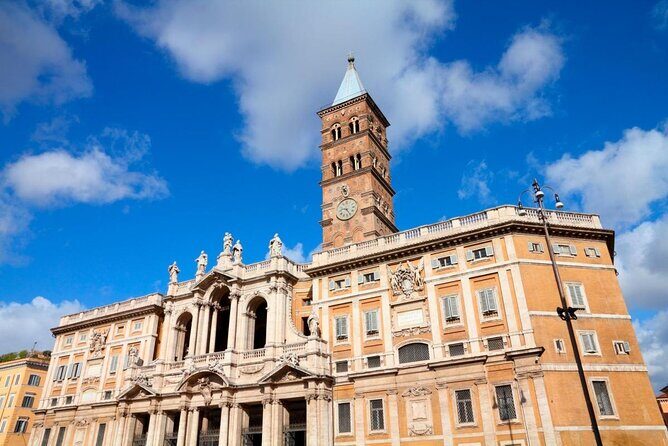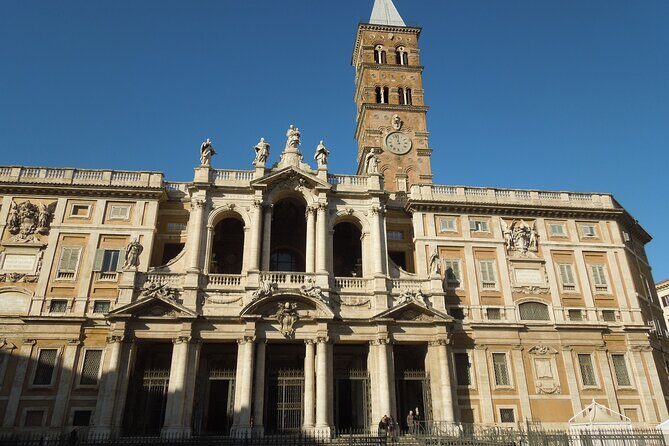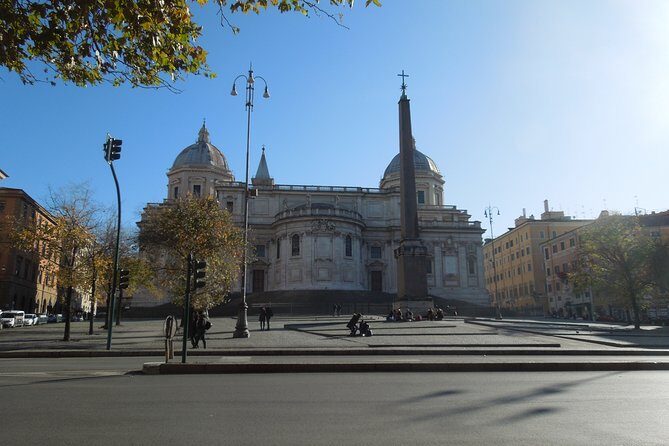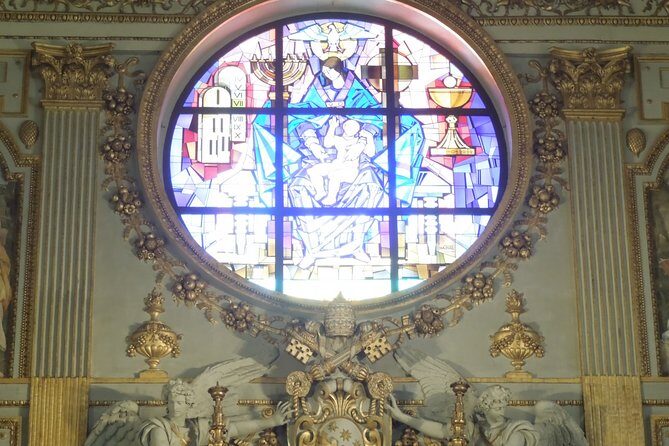A Close-Up Look at Rome’s Papal Churches with a Private Guide

Imagine walking through the heart of ancient Rome, where history and faith intertwine in breathtaking architecture and shimmering mosaics. This Papal Churches of Rome Special Jubilee Tour with a private guide offers just that—an intimate journey into three remarkable basilicas, each with its own story to tell. For $340.34 per person, you’ll spend roughly three hours exploring Basilica di Santa Maria Maggiore, San Pietro in Vincoli, and Basilica di Santa Prassede—a perfect blend of well-known and lesser-known gems.
One of the reasons we find this tour appealing is the personalized attention you get from your private guide, who is not only knowledgeable but also attentive to your interests. We also love the way the tour combines art, relics, and architecture, giving you a well-rounded understanding of Rome’s ecclesiastical history. On the flip side, keep in mind that the tour is walking-based and might be a bit brisk for those with mobility challenges or who prefer to linger longer inside each church.
This tour is best suited for travelers who appreciate history, art, and authentic spiritual atmospheres—especially those interested in exploring beyond the usual tourist spots. If you’re eager for a deeper, more personal connection to Rome’s religious heritage, this could be just the right experience.
Key Points
- Personalized Experience: Private guide offers tailored commentary and more attention.
- Historical & Artistic Highlights: See mosaics, relics, tombs, and works by disciples of Michelangelo and Raphael.
- Authentic Atmosphere: Visit lesser-known basilicas that are often overlooked in busy group tours.
- Value for Money: An in-depth, three-hour journey into Rome’s spiritual and artistic soul.
- Convenient Location: Starts at Piazza di Santa Maria Maggiore, accessible with public transportation.
- Flexible End Point: Tour concludes along Via Urbana, allowing for continued exploration.
Prefer personalized experiences? Here are other private options we've covered in Rome
Exploring Rome’s Sacred Architecture with a Personal Touch

Walking into Rome’s Basilica di Santa Maria Maggiore, you immediately sense its importance. It is the oldest Marian shrine in the West and one of the four papal basilicas. With its sturdy Romanesque mosaics, 5th-century relics, and the Holy Door that opens during jubilees, it’s an ideal place to start. Our guide, who we’ll call Marco, shared interesting tidbits about the church’s history, such as how it preserves its original early Christian structure despite later additions. These details help you appreciate the layers of history in every stone and mosaic.
The mosaics are particularly striking, with well-preserved images from Roman times that bring the past vividly to life. Marco explained that some of the artwork depicts biblical scenes, and we loved the way he pointed out subtle details often missed by the casual visitor. The chapels dedicated to popes like Sixtus V and Paul V add a baroque flair, and we appreciated hearing stories behind each tomb.
We then moved on to San Pietro in Vincoli, built in the 5th century and famous for housing Saint Peter’s chains. The name “in Vincoli,” meaning “in chains,” comes from the relics displayed beneath the high altar. Here, your guide highlights the significance of these chains, which symbolize Saint Peter’s imprisonment and are displayed annually on August 1st. The basilica’s architecture is quite modest compared to Santa Maria Maggiore, but the relics and their stories make it a highlight.
The last stop, Basilica di Santa Prassede, feels almost like a hidden treasure. Built in the 9th century, it’s renowned for its exquisite mosaics of saints and the figure of Christ in the vault. Marco pointed out the vivid scenes and explained that the church houses what’s believed to be a segment of the pillar where Jesus was flogged. As we admired the mosaics, we also glimpsed Bernini’s first sculptural work, an unexpected bonus in this small basilica.
Each church offers a unique window into different eras of Rome’s religious art and architecture, from early Christian mosaics to baroque tombs. As Marco guided us, it became clear how these spaces served not just as places of worship but as repositories of cultural history.
In-Depth Breakdown of the Itinerary

Basilica di Santa Maria Maggiore
Located on the Esquilino Hill, it’s the largest Marian church in Rome and one of the four papal basilicas. Its significance lies in its continuous use since the 5th century, making it a cornerstone of Rome’s Christian history. You’ll love the early Christian mosaics depicting biblical stories, preserved remarkably well. The church’s architecture is a mix of original structures and later additions, which adds to its layered charm.
Your guide will point out notable features like the Holy Door, which is ceremonially opened during jubilees, and the chapels of popes, richly decorated with paintings from disciples of Raphael and Michelangelo. The tombs of various pontiffs add a sense of continuity and reverence. We found the atmosphere both majestic and intimate—an essential stop for anyone wanting to grasp the spiritual heart of Rome.
San Pietro in Vincoli
Built in the 5th century, this basilica’s claim to fame is housing Saint Peter’s chains. These relics are displayed beneath the high altar, and it’s a powerful moment to see them. Marco shared that these chains symbolize the suffering and perseverance of the early saints, giving visitors a tangible connection to the past.
The basilica’s simple façade gives way to an interior where relics and artworks tell stories of faith and history. The church is smaller and less crowded than Santa Maria Maggiore, which makes it easier to focus on the relics and the architecture. The story of the chains is a reminder of how physical artifacts can serve as powerful symbols of spiritual resilience.
Appreciate having local insight? Here are other guided experiences in Rome we've examined
- Rome: Colosseum, Roman Forum and Palatine Hill Guided Tour
- Rome: Colosseum, Roman Forum and Palatine Hill Guided Tour
- Expert Guided Tour of Colosseum Arena OR Underground, and Forum
- Rome Street Food Tour with Local Guide
- Vatican Museums, Sistine Chapel & St Peters Basilica Guided Tour
- VIP Vatican Breakfast and Guided Tour with Sistine Chapel Access
Basilica di Santa Prassede
This small gem, built in the 9th century, is packed with vivid mosaics depicting saints, angels, and the Savior. Marco explained that the church was restored multiple times, but its mosaics remain some of the finest examples of medieval Christian art. We loved the scene of Christ in the medallion and the detailed figures of saints lining the walls.
The church also houses relics such as the segment of the pillar where Jesus was flogged, adding a layer of tangible history. Bernini’s first sculpture is tucked away here, giving visitors a glimpse of the artist’s early work. The quiet, contemplative atmosphere makes it an ideal spot for reflection after visiting the larger, busier basilicas.
What You Can Expect from the Experience
Expect a walk-and-talk style tour, with plenty of opportunities to ask questions. Your guide will navigate you through narrow streets, pointing out interesting details and stories along the way. The pace is steady but manageable, leaving ample time to admire mosaics, relics, and architecture.
Since this is a private tour, the experience feels more personalized. The guide can adapt the narrative to your interests, whether you want to focus more on art, history, or spiritual significance. The cost reflects this exclusivity, but many travelers find it well worth the investment for a rich, tailored experience.
You’ll love the way the guide explains the symbolism behind mosaics and relics, helping you see beyond the surface. The tour concludes along Via Urbana, giving you the flexibility to continue exploring Rome at your leisure.
Practical Details and Considerations
The tour starts at Piazza di Santa Maria Maggiore, a central location accessible by public transportation. It lasts approximately three hours, making it a manageable half-day activity. Because it’s walking-based, comfortable shoes are a must, especially on cobblestone streets.
The cost of $340.34 per person includes a dedicated guide and the private nature of the experience. It does not include hotel pickup or drop-off, so plan to meet at the starting point. Remember, Rome’s strict dress code applies—cover shoulders and knees—so dress appropriately for entering churches.
This tour is highly recommended for those with a genuine interest in Rome’s religious art and history, or travelers who value personalized attention and detailed storytelling. Based on reviews, guests appreciate guides who are knowledgeable and friendly, making the experience both educational and enjoyable.
The Sum Up: Who Should Consider This Tour?

If you’re looking for an up-close, insightful exploration of Rome’s religious architecture and art—beyond the crowded main sights—this private tour offers a perfect balance of depth and intimacy. It’s especially great for history buffs, art lovers, or anyone eager to understand the spiritual significance behind these historic buildings.
The tour’s focus on lesser-known basilicas like Santa Prassede means you’ll see some of Rome’s most beautiful mosaics without the crowds typical at more famous sites. The personalized approach ensures you get tailored stories and insights, making your visit more meaningful.
While the price is higher than a group tour, the private guide experience and exclusive access to art and relics make it worth the investment. It’s ideal for travelers who want a detailed, respectful atmosphere and the freedom to ask questions and explore at their own pace.
In the end, this tour is a wonderful way to connect with Rome’s spiritual and artistic past in a way that feels personal, authentic, and deeply enriching.
FAQs
Is the tour suitable for children or seniors?
Since the tour involves walking and visiting churches with strict dress codes, it’s best suited for those able to walk comfortably and follow dress requirements. Seniors with good mobility should find it manageable, but those with mobility issues might want to consider other options.
How long does the tour last?
Approximately three hours, giving enough time to enjoy each stop without feeling rushed.
Are the churches inside accessible with a stroller or wheelchair?
The information doesn’t specify accessibility details, so it’s best to contact the provider directly for specific needs.
Do I need to book in advance?
Yes, most travelers book about 25 days ahead. The tour is popular, especially during peak seasons.
Are there any hidden costs?
The price includes the guide and the private experience. You’ll need to cover your own transportation to the meeting point and any additional entrance fees if applicable, though the listed sites are free to enter.
Is a dress code enforced?
Yes, knees and shoulders must be covered for both men and women to enter the churches.
Can I continue exploring Rome after the tour?
Absolutely. The tour ends along Via Urbana, which is centrally located and offers easy access to other parts of the city.
More Guided Tours in Rome
- Pantheon Private Guided Tour – Rome’s Iconic Ancient Temple
- Rome: Vatican Museums and Sistine Chapel Guided Tour
- Vatican Museums & St. Peter’s Basilica guided tour
- Piazza Navona, San Luigi dei Francesi and Pantheon Guided Tour
- Colosseum, Roman Forum and Palatine Hill Guided tour
- Rome: Best of Colosseum and Roman Forum Guided Tour
More Tours in Rome
More Tour Reviews in Rome
- Rome: Vatican Museum & Sistine Chapel Skip-the-Line Tickets
- Pantheon Private Guided Tour – Rome’s Iconic Ancient Temple
- Hidden Rome Tour: Interactive Walking Quest
- Church of Jesus Christ of Latter Day Saints – Visit Mormon Temple in Rome
- Private transfer from Rome to Sorrento
- Rome: Pub Crawl & Ultimate Party Tour
More Rome experiences we've covered
- Rome’s 15 Top Wine Tours
- Our Picks For The 5 Best Vegan & Vegetarian Tours In Rome
- Our 15 Favorite Rome Lunch Experiences
- The 15 Most Popular Food Tours In Rome
- Rome’s 15 Top Dinner Experiences (With Prices)
- 15 Fantastic Dining Experiences In Rome
- 4 Best Craft Beer Tours In Rome
- Rome’s 3 Best Coffee Tours: Which To Choose?
- 15 Top Workshops & Classes In Rome (With Reviews & Prices)
- 15 Most Highly Rated Walking Tours In Rome
- The 15 Most Popular Tours In Rome
- 6 Most Highly Rated Spa & Hot Springs Experiences In Rome
